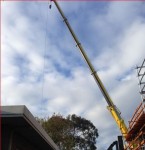CRANE JIBS OVERHANGING ADJACENT PROPERTIES
The basic principle of law is that a landowner owns rights that stretch from the centre of the planet to the airspace above the land. Legislation has given aircraft the rights to pass above the land without causing any trespass, but the basic principle holds good nearer the ground. This means that the jib of a tower crane swinging across land owned by an adjoining landowner is trespassing.
The use of tower and gantry cranes are now commonplace on building sites able to provide lifting capacity while occupying a minimal footprint on the land. An inevitable consequence of the use of cranes sites is that the jib of the crane will oversail adjacent sites. Even if the
operation of the crane can limit the swing of the jib, safety and structural stability require that when the crane is not in use the jib must be left to swing in the wind, giving a circle of oversailing with a radius equal to the length of the jib from the mast of the crane. Any property within that circle will potentially be oversailed.
There is more a concern of jib oversailing in the Manningham Residential Strategy which which covers large areas along main roads and among established residential areas surrounding where developments between 11 m to 14.5 m are more likely to occur on much much smaller blocks along side established houses and cluster developments.
Lovegrove Smith & Cotton..Crane Oversail – The Overhanging Legal Issues For Developers, Builders And Owners.
The issue of cranes overhanging property can cause particularly vitriolic exchanges between parties and in many cases an adjoining owner will already feel aggrieved by the fact that a large high density building is being constructed next door which may make it difficult for the both parties to deal with the question of a crane boom overhanging dispassionately. Meanwhile the builder/developer may not appreciate that an adjoining owner has rights in relation to airspace which needs to be compensated for.
However a calm approach from both parties will more than likely lead to the best results. Once again legal advice may be helpful, as it allows the legal advisers to dispassionately negotiate an appropriate licensing agreement which adequately compensates and protects the rights of the adjoining owner while allowing the builder to proceed with minimal disruption. In the event that a licensing agreement cannot be agreed, or a crane is allowed to overhang a neighbouring property without a license in place, the parties will have to resort to legal action, either at common law, or pursuant to the relevant statute, depending on the jurisdiction. There is a significant risk that a builders could have an injunction awarded against them preventing them from using the crane on site. This could have huge economic impacts on the developer. However courts in other cases have been inclined to resolve these matters by allowing overhanging, and ordering appropriate compensation. It would seem to be in the economic interests of both parties as well as the wider community if these disputes can be resolved without resort to the court system.
Lovegrove Smith & Cotton
By Steven Smith and Alex Milne




4 Comments
My advice to property owners in established residential areas, who have a high density building about to commence on a small block next door, is to remind the developer that the crane boom/jib should not trespass above your land without permission. It should be made clear that they cannot expect to do any better by an unlawful trespass than by sitting down with adjoining owner/s and negotiating a fair compensation. It is my understanding that a successful injunction for trespassing would not have to prove damages.
It could be stressful, better to engage a solicitor to sort it out with council and the developer, more so if you are a member of a body corporate.
I would go straight to council and let them negotiate compensation not only for permission to trespass above your land but for having to close windows to avoid the dust which still gets in,. the lack of proper sleep especially for anyone who works night shift, the parking problems, the noise and vibrations especially the pile driving which seem to go on forever. Yelling etc, lots of inconvenience. You have to remember a lot of them have industrial deafness, or the makings of, so yelling to some is normal volume. Council have betrayed its ratepayers by foisting the high density into our residential areas so let them do the negotiation for you.
For safety reasons a crane is allowed to slew around in a 360 degree fashion, this is to prevent the crane from collapsing in high winds. The reality is if the boom of the crane was locked into a stationary position during a storm, strong winds would have the potential to place enough force on the crane to cause it to collapse.